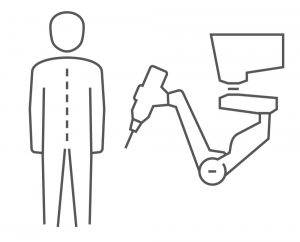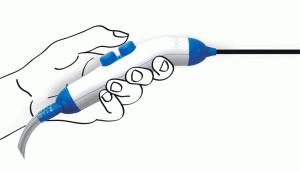The past twenty years has marked a revolution in minimally invasive surgery with the expansion into more complex areas of surgery and the introduction of new techniques such as Natural Orifice Transluminal
 Endoscopic Surgery (NOTES) and Laparo-Endoscopic Single Site Surgery (LESS).
Endoscopic Surgery (NOTES) and Laparo-Endoscopic Single Site Surgery (LESS).
Robotic surgery has also emerged as an important innovation that can even replace standard laparoscopy for some surgical interventions.1 Early comparisons between the DaVinci robotic system and conventional laparoscopy showed that surgical exercises could be carried out more rapidly and efficiently.2
 In 2001, the first remote robotic surgery was successfully performed on a patient in Strasourg by surgeons in New York demonstrating how the robotic approach has the potential to bring surgical expertise to any location.3
In 2001, the first remote robotic surgery was successfully performed on a patient in Strasourg by surgeons in New York demonstrating how the robotic approach has the potential to bring surgical expertise to any location.3
Robotic surgery was developed to meet an increasing demand for greater surgical precision and safer operations.4 Patient safety has always been central to the evolution of surgery care. Robotic surgery provides the surgical team with better 2D and especially 3D visualization, helping to improve the surgeon’s dexterity and ease of surgery in general.5,6 It also plays an important role in facilitating an interdisciplinary approach, particularly where more complicated procedures are necessary.7
Robotic systems are becoming increasingly sophisticated. For example, a European initiative called the STIFF-FLOP project was launched in 2015

(STIFFness controllable Flexible and Learnable Manipulator for surgical Operations).8
The aim was to develop an articulating robotic arm that could stiffen its parts offering surgeons the benefit of enhanced movement control. Overall robotic surgery has given surgeons greater confidence and satisfaction which positively influence performance in the operating theatre.5
Compared to open surgery, minimally invasive techniques have significant benefits for patients such as reduced wound access trauma, shorter hospital stays and less postoperative wound complications.4 Robots can offer surgeons further advantages such asimproved visualization and a greater level of surgical precision to improve surgical outcomes.4 In the field of urology, for instance, evidence has shown that robotic prostatectomy was associated with significantly less blood loss compared with open surgery.9 A recent study, published in 2022, comparing recovery and morbidity after robotic-assisted radical cystectomy versus open radical cystectomy found that the median number of days alive and out of

the hospital within 90 days of surgery was 82 for patients undergoing robotic surgery versus 80 for open surgery (p= 0.01). Overall, patients who underwent complete robotic radical cystectomy spent statistically significantly more time out of the hospital than those receiving open surgery (shorter stay and less re-admission).10 Patient satisfaction with robotic surgery is high. According to a survey of 140 patients who had robotic-assisted surgery within Gynae Oncology, nearly all patients (99%) were pleased with their care and 91% said they would recommend robot-assisted surgery as a modality.11
The advent of new technologies has impacted how surgeons are trained and led to the development of specific competency-based training programs6. Several dedicated training facilities have been set up to focus on the safe and effective implementation of these technologies into medical practice. For example, IRCAD, research

and training institute affiliated with the University of Strasbourg in France, offers a wide range of specialist courses including robotic-assisted training for colorectal, urological and general surgery. The ORSI Academy in Melle, Belgium is another state-of-the-art training and expertise centre for minimally invasive & robotic surgery. It offers healthcare professions access to scientifically validated training programs that have been endorsed by scientific societies and universities.
Even though robotic surgery offers many advantages, there are some drawbacks such as the absence of tactile feedback for the surgeon when operating as well as higher equipment costs and longer set up time.12 Nevertheless robotic-assisted technology continues to evolve as research and development into artificial intelligence increases, bringing about further changes to surgical practice.13 
Despite the significant progress that has been made in laparoscopic surgery since the year 2000, one imperative has not changed: the need for a simple, reliable suction and irrigation device to keep the operating field clear. Elefant® (Coloplast) is used extensively by surgical teams across a wide range of laparoscopic procedures in urological and gynaecological surgery. Elefant® is a single-use, suction-irrigation device that was developed 20 years ago for laparoscopic and robotic laparoscopy. 14,15 It is designed for use through a trocar, away from the robot arms, and controlled by a bedside assistant, usually a nurse or resident. As it is a disposable device, Elefant® avoids the risks of cross-contamination and the costs associated with post-procedure sterilization.
In contrast to conventional suction and irrigation devices which are made of metal and stainless steel, Elefant®’s cannula is made of E fibre glass which is non-conductive and not-traumatic. Moreover, the cannula includes Yankauer tip with 6 distal holes that prevents suction of the neighbouring tissues. From a practical point of view, Elefant® has a handling grip which is easy to use: it is a light, ergonomic grip for comfortable and easy manipulation by both right- and left-handed users.
Last but not least, Elefant® has two separate tubing channels with a larger diameter compared to the diameter of the cannula. In addition, there is no decrease in the diameter of these tubes even in the trumpet system, which also reduces the risk of obstruction.
All Elefant® features have been designed to support laparoscopic surgeries and surgical practice..
Elefant® is featured in surgical atlases for laparoscopic prostatectomy and bladder surgery.14,15 Today, Elefant® continues to play a key role in laparoscopic surgery and it has gained the confidence of surgeons and their teams worldwide to support a wide variety of laparoscopic procedures.
